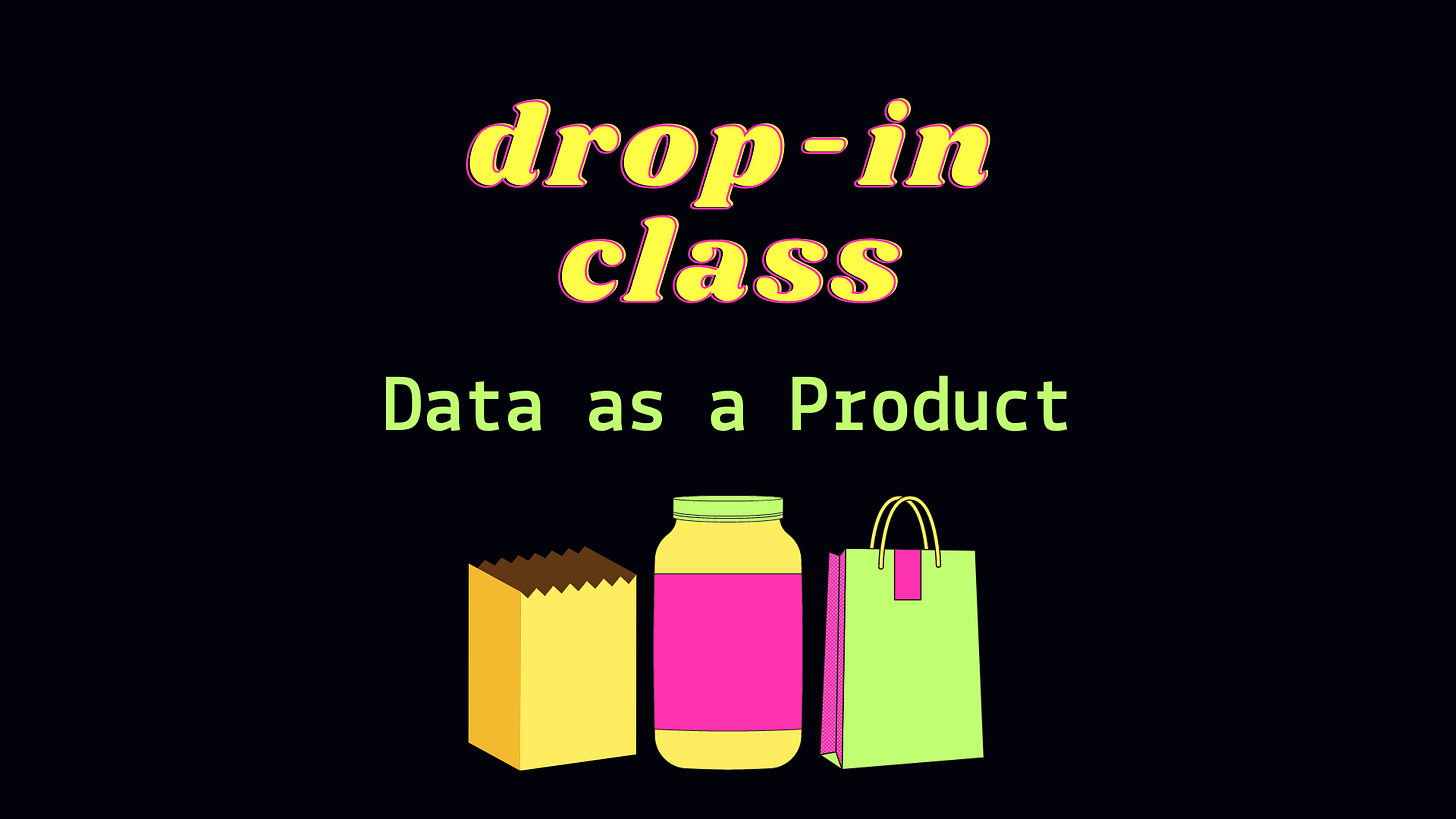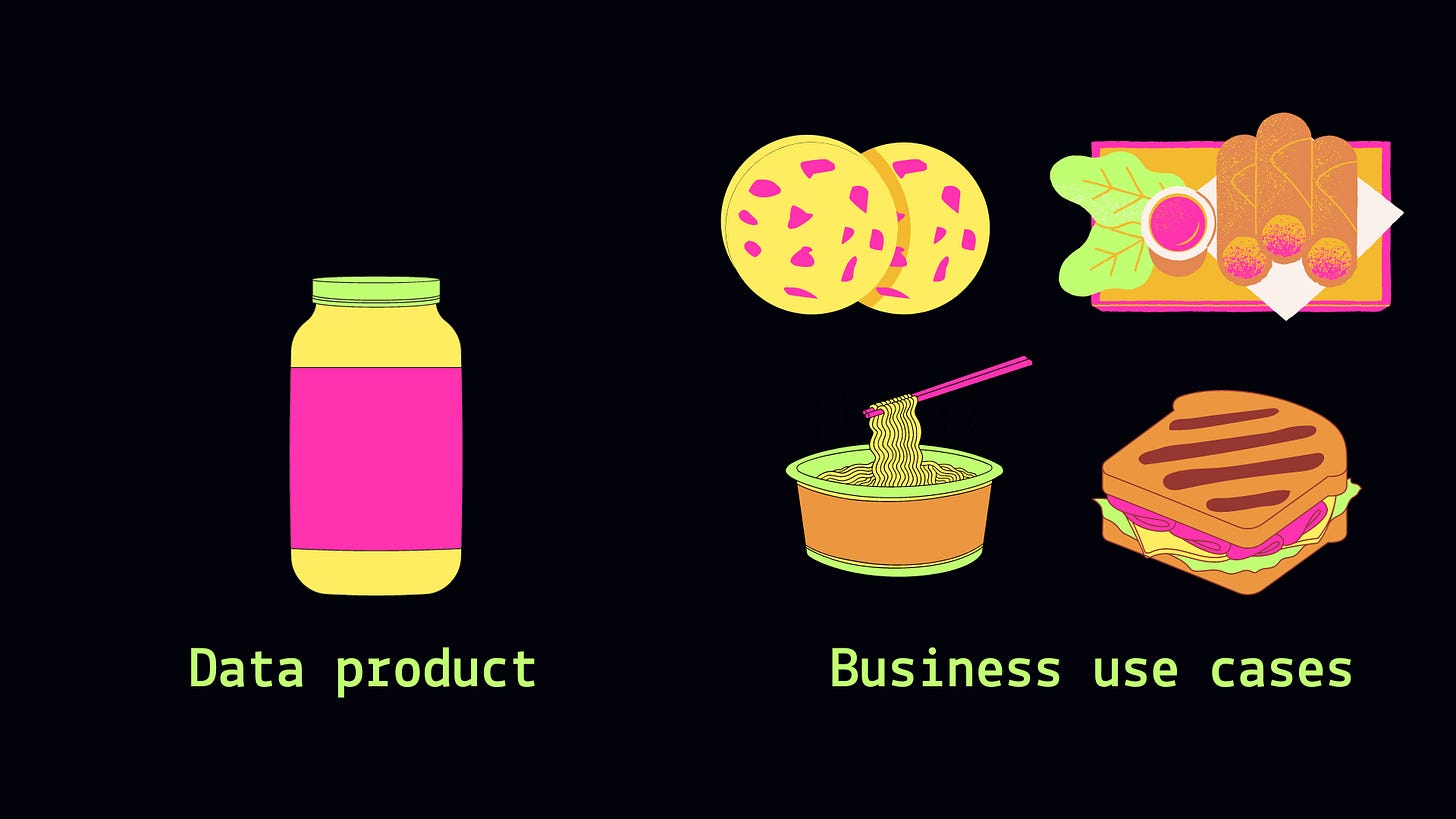Drop-In Class #7: Data as a product: Treating data like peanut butter
How internal datasets should be viewed like a CPG product
Welcome to my newsletter, which I call Drop-In Class because each edition is like a short, fun Peloton class for technology concepts. Except unlike a fitness instructor, I'm not an expert yet: I'm learning everything at the same time you are. Thanks for following along with me as I "learn in public"!
Why “data as a product” matters right now
“Data as a product” is a trendy topic. Probably because businesses are under a lot of economic pressure these days, and starting to get antsy about showing business results from their data. They need to make data more usable.
But before we dive into data products, let’s think about consumer products. Like makeup and peanut butter.
I did not start my career in technology. My internships were with Ulta Beauty, and then at a global PR agency called Ketchum working on CPG brands like Smucker’s and Whirlpool. So I’ve seen the process of designing a product with the end consumer in mind. Smucker’s wouldn’t launch a new type of peanut butter unless they did a ton of market research, talked to customers, and made sure there would be demand. Common sense, right?
Yet many companies don’t follow that process for their internal data, because it’s counterintuitive. Data is a mess, so we focus on solving the technical problems first, THEN start thinking about the business problems.
So data engineers and analysts do the hard work of building pipelines and getting the data in beautiful shape — only to find that it’s not being used. Accenture calls it “dormant data.”
“Data as a product” is a methodology for making sure data is consumable. Cue the music and let’s see what it means to treat data like peanut butter!
Data as a product: Building datasets with the end consumer in mind
We’ve figured out many of the technical challenges of data. The cloud data warehouse and data lakehouse gave us the scalability and flexibility we need to manage bigger datasets and process it all more efficiently.
But we’ve ended up with a lot of unused data hanging around, looking for a business problem. Because organizations build all these modern data processes without considering how end consumers in the business will realistically use any of it. So we need to start thinking more like a CPG brand.
“Data as a product” is about viewing your company’s data as a product for the business. The idea is to apply consumer product best practices to developing data products. Think of the data team as the producers, and the business users who need data insights as the customers.
What is a data product? You’ll hear different definitions — datasets, dashboards, metadata, machine learning models, code, APIs, and so on.
I like to think of a data product as the complete package. The full process that gets data from the source to the business decision. The raw peanuts, the peanut processing plant, the shipping, all the way to the nicely labeled jar on the shelf that someone can pick up and take home to put in a sandwich.
Here are key principles for building a data product. You’ll notice it’s a lot like making a good CPG product:
Collaborate with the consumers. Data teams should work with business teams to understand their needs and identify use cases.
It’s not just about the data, it’s about the packaging. You need to make a dataset well-documented and easy to understand, with metadata and descriptions. Like everything you’d put on a food label: Where did it come from? What’s in it? What could it be used for?
Establish quality and reliability. Your consumers need to trust the data. Is the business getting the most up-to-date version of the data? Is the data monitored for quality issues? What happened to the data at each step of preparation? If your peanut butter has a questionable expiration date and you’re not sure where it came from, it’s not going in your sandwich.
Make data discoverable. How would you buy anything if you couldn’t find it in a store? Make sure there’s a distribution method for your data. Business users need a way to discover the data and analyze it.
How does the data-as-a-product mindset make data more valuable?
Data as a product sounds like a lot of upfront work, right? But it keeps the focus on business use cases, so that you can get something out of your data instead of the dreaded “dormant data.” You know you’ve built a good data product when:
Data is more reusable: Build a data product once, use it many times for multiple use cases. Just like Smucker’s develops peanut butter that can be used by many people for many recipes, instead of creating a specific butter for one specific person at a time for one specific thing.
Business users can quickly apply richer use cases: When they treat data as a product, organizations can reduce the time it takes to implement data in new use cases by as much as 90%.
Everyone knows that peanut butter is great for making sandwiches. But only a true peanut butter enthusiast would think to put peanut butter in instant ramen, as I started doing in college. Your domain experts know the possibilities, and they can experiment with higher-value use cases for data.
(Did you know peanut butter is a good way to get chewing gum out of your hair? There has to be a good analytics use case analogy for this.)
Once you get in the mindset of thinking about data as a product, a lot of other trending data tools and strategies make sense. These all support a data-as-a-product approach:
Data catalogs: They borrow from the same retail analogy I use! Much like an Ulta Beauty store catalog, a data catalog enable users to find and access relevant datasets efficiently.
Data mesh: This is an architecture concept that promotes business domain ownership of data. “Data as a product” is one of the fundamental pillars of data mesh.
Metrics stores: Where data teams centrally define how business metrics are calculated from data (like “Average quarterly sales”).
So that’s why you might hear more about “data as a product” these days. When you treat data like a product, your company might make more money with data insights instead of making…peanuts!
Extra credit reading
This is a 101-level drop-in, so I barely scratch the surface of each topic. For deeper reading, check out these great sources:
How to Treat Your Data As a Product (Monte Carlo)
How to unlock the full value of data? Manage it like a product (McKinsey)
A Better Way to Put Your Data to Work (Harvard Business Review)
Shifting mindsets: why you should treat data as a product (Thoughtworks)
Thank you so much for reading! I’ll see you in the next one.
‘Til next drop-in,
Alex



